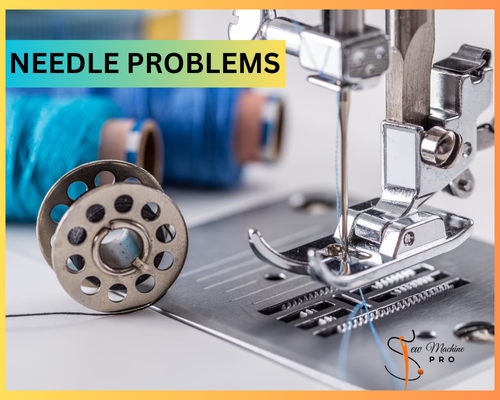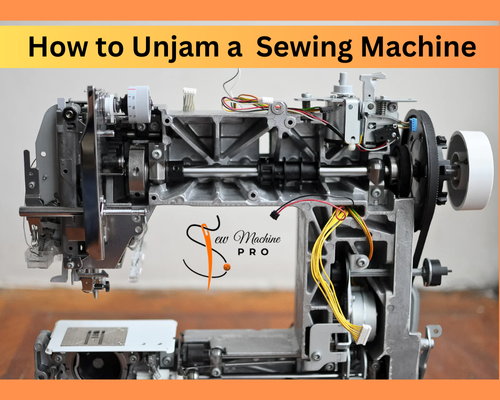
However, understanding the common causes of these jams can help you prevent them in the future. Generally, the issues can be attributed to these main areas: problems with the thread, needle issues, bobbin cases, and inadequate machine maintenance. Whether it’s due to improper threading, using the wrong needle, a dirty bobbin case, or neglecting regular upkeep, addressing these factors can significantly reduce the likelihood of your sewing machine jamming.
The primary contributing factors that explain the occurrences leading to the jamming of your sewing machine are as follows:
Thread related issues
Threading problems often cause sewing machine jams and can result in frustrating issues such as thread bunching, jamming in the bobbin area, or the thread repeatedly coming out of the needle. Let’s take a closer look at these problems and how to fix them:
1. Common Threading Issues
1- Improper Threading: If the upper thread is not correctly threaded through all the guides, tension discs, or the needle eye, it can result in thread bunching or jamming. Misthreading often leads to issues such as the bobbin thread bunching under the plate or the thread jamming in the bobbin area. To prevent this, ensure proper threading by following your machine’s manual and rechecking the thread path.
2- Thread Coming Out of the Needle: If your thread keeps coming out of the needle, it may be due to incorrect threading or an improperly inserted needle. Make sure the thread passes through all the necessary guides and tension discs, and double-check the needle’s position.
3- Bobbin Thread Bunching: A common issue is the bobbin thread bunching under the plate. This often happens due to improper bobbin threading or incorrect insertion into the bobbin case. Make sure the bobbin is wound evenly and placed correctly in the case.
4- Tension Problems: Incorrect tension settings, whether too tight or too loose, can lead to thread bunching or breakage. If the bobbin thread keeps jamming, try adjusting the upper thread tension first.
2. Preventing Future Threading Problems

- Regular Cleaning: Lint, dust, and thread fragments can obstruct the thread path and cause frequent jamming. Regular cleaning of the bobbin area and thread path using a lint brush or tweezers is vital to keeping your sewing machine running smoothly.
- High-Quality Thread: Low-quality or old thread tends to fray, break, or shred, leading to jamming. Using high-quality thread suited for your machine and fabric will prevent these issues and ensure smoother stitching.
Bobbin area problems
The bobbin is a critical part of your sewing machine as it provides the bottom thread for your stitches. However, bobbin issues are one of the most common reasons for sewing machine jams. Here’s a simple breakdown of potential bobbin problems and how to prevent them:
1. Winding Issues
If the bobbin is not wound correctly—either too loose or too tight—it can lead to problems like uneven tension and thread tangling. Why does my bobbin keep jamming? This often happens when the thread isn’t distributed evenly on the bobbin. Make sure to wind the bobbin smoothly and avoid overfilling it. A well-wound bobbin ensures even tension, preventing bobbin jams in your sewing machine.
2. Incorrect Bobbin Insertion
One common reason for a sewing machine’s bobbin getting jammed is improper insertion. When the bobbin is not placed correctly into its case, the thread may not flow smoothly, resulting in tangles. Always consult your sewing machine manual to ensure that the bobbin is inserted correctly and that the thread is pulled through the tension slots properly.
3. Low-Quality or Wrong Thread
It’s important to remember that using the wrong thread type or low-quality bobbin thread can cause the thread to break or shred, leading to bobbin jams. Make sure to choose thread that matches the fabric you’re sewing and is compatible with your machine. Avoiding cheap thread will help minimize jams.
4. Dirty Bobbin Case
Lint, dust, or small thread fragments can build up in the bobbin area, leading to blockages. When the bobbin keeps jamming, it’s often because of debris in the bobbin case. To solve this issue, remove the bobbin and clean out the case using a small brush or compressed air. It’s important to regularly clean your sewing machine, especially the bobbin case, to prevent thread jams.
Needle problems

Needle-related issues are a frequent cause of sewing machine jams and can disrupt your sewing process. Here’s an overview of common needle problems and how to avoid them:
1. Bent or Dull Needle
A bent or dull needle can cause a sewing machine needle to jam or prevent the thread from passing smoothly through the fabric. Bent needles often result in skipped stitches, fabric snags, or broken threads. If you’re asking, “Why does my thread keep coming out of the needle?” it could be due to a bent needle, causing irregular thread movement. It’s essential to replace your needle every 8-10 hours of sewing or after completing a project to avoid these issues.
2. Wrong Needle Size or Type
Using the wrong needle size or type for your fabric is a major cause of jams. For example, using a ballpoint needle on leather or a needle meant for lightweight fabric on heavy materials like denim can result in poor stitching and frequent jams. Pairing the right needle type with the fabric is crucial. For instance, sharp needles work best for lightweight fabrics, while jeans needles are designed for thick, heavy fabrics like denim.
3. Incorrect Needle Insertion
One common cause of sewing machine jams is an improperly inserted needle. The needle must be fully inserted with the flat side facing the correct direction, usually toward the back. If it’s not inserted properly, it can lead to problems like thread bunching or frequent jams. Always double-check the needle’s position before you begin sewing.
4. Needle Breakage
When a needle breaks in the middle of a sewing project, it can cause the sewing machine to stop working. This can occur due to using the wrong needle for the fabric or using low-quality needles. If you find that needles are breaking often, check the sewing surface and make sure you are using the correct needle for your material. Furthermore, a broken needle can lead to thread tangles, resulting in jams in the bobbin area.
Preventing Needle Jams
- Remember to change your needle regularly, especially after completing each project, to avoid sewing machine needle jams.
- Make sure to choose the right needle size and type for the fabric and thread you are using.
- Always ensure that the needle is inserted properly, and replace it immediately if you notice any bending or dullness.
Maintenance issues
Maintaining your sewing machine is crucial for preventing jams and ensuring smooth operation. Whether it’s due to lint buildup, improper lubrication, or tension issues, regular care can prevent you from constantly wondering, “Why does my sewing machine keep jamming?” Here are some maintenance tips to help you keep your machine in top shape:
1. Clean Out Lint and Debris Regularly
Remember to clean your sewing machine regularly to prevent jams. Lint and dust can cause issues, especially around the bobbin area and feed dogs. Use a small brush or compressed air to clear out debris after every few projects, especially with fabrics like fleece or flannel. Regular cleaning can prevent thread tangling and jamming.
2. Lubricate Moving Parts
Oiling your sewing machine regularly is important to keep the internal parts moving smoothly. Refer to your manual to locate the lubrication points, typically around the bobbin case and other moving components. Applying a few drops of sewing machine oil as instructed helps prevent wear and friction, which can lead to jams. Neglecting lubrication can cause metal parts to rub together, resulting in a jammed sewing machine bobbin.
3. Follow a Maintenance Schedule
Create a regular cleaning and maintenance routine for your sewing machine:
Daily: Wipe down the machine and replace the needle if needed.
Weekly: Clean the bobbin area and feed dogs to remove lint buildup.
Monthly: Oil the machine and check tension settings.
Annually: Consider taking your machine for a professional tune-up to ensure everything is running smoothly.
How to Unjam a Sewing Machine

Unjamming a sewing machine is a simple process if you follow the right steps. Here’s a guide to help you unjam a sewing machine and prevent future jamming:
1. Turn Off and Unplug the Machine
Safety should always come first—make sure to turn off and unplug your sewing machine before attempting any repairs to prevent accidental injury.
2. Remove the Fabric
Carefully remove any fabric that is stuck in the machine. If it is caught, avoid pulling too hard to prevent more damage. Lift the presser foot to release tension on the fabric and make it easier to remove.
3. Open the Bobbin Case
Many jams occur in the bobbin area. Open the bobbin case and remove the bobbin. Check for any tangled thread or debris. Clear any visible thread snags with small scissors.
4. Check the Needle
A bent or dull needle can cause a jam. If your needle is bent or broken, remove it and replace it with a new one. Always ensure that the needle is properly inserted, with the flat side facing the back of the machine.
5. Clean Out the Bobbin Area
Lint, dust, or loose threads can accumulate in the bobbin case, leading to jams. Use a small brush or compressed air to clean out the bobbin area and feed dogs, as debris buildup can cause sewing machine jams.
6. Re-thread the Machine
After clearing the jam, re-thread the machine. Ensure that both the upper thread and bobbin thread are properly threaded. Misthreading is a common cause of jamming in your sewing machine.
7. Adjust Thread Tension
Incorrect thread tension may lead to jamming. After re-threading, test the tension by sewing a few stitches on scrap fabric. Adjust the tension as necessary to prevent future jams.
8. Test the Machine
After making the necessary adjustments, test your machine on scrap fabric to ensure the issue is fixed and no lingering problems with jamming.
By following these steps and performing regular maintenance, you can prevent sewing machine jams and keep your machine running smoothly. Regular cleaning, proper threading, and routine lubrication will significantly reduce the risk of future jams.
FAQs on Sewing Machine Jamming
References
